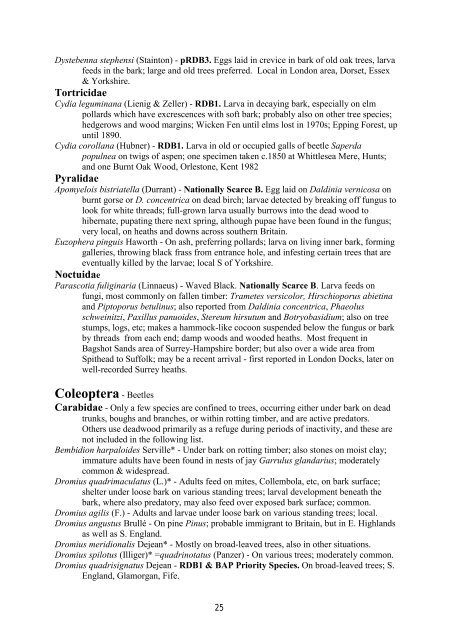Crustacea: Copepoda - Cerambycoidea.com
Crustacea: Copepoda - Cerambycoidea.com
Crustacea: Copepoda - Cerambycoidea.com
Create successful ePaper yourself
Turn your PDF publications into a flip-book with our unique Google optimized e-Paper software.
Dystebenna stephensi (Stainton) - pRDB3. Eggs laid in crevice in bark of old oak trees, larva<br />
feeds in the bark; large and old trees preferred. Local in London area, Dorset, Essex<br />
& Yorkshire.<br />
Tortricidae<br />
Cydia leguminana (Lienig & Zeller) - RDB1. Larva in decaying bark, especially on elm<br />
pollards which have excrescences with soft bark; probably also on other tree species;<br />
hedgerows and wood margins; Wicken Fen until elms lost in 1970s; Epping Forest, up<br />
until 1890.<br />
Cydia corollana (Hubner) - RDB1. Larva in old or occupied galls of beetle Saperda<br />
populnea on twigs of aspen; one specimen taken c.1850 at Whittlesea Mere, Hunts;<br />
and one Burnt Oak Wood, Orlestone, Kent 1982<br />
Pyralidae<br />
Apomyelois bistriatella (Durrant) - Nationally Scarce B. Egg laid on Daldinia vernicosa on<br />
burnt gorse or D. concentrica on dead birch; larvae detected by breaking off fungus to<br />
look for white threads; full-grown larva usually burrows into the dead wood to<br />
hibernate, pupating there next spring, although pupae have been found in the fungus;<br />
very local, on heaths and downs across southern Britain.<br />
Euzophera pinguis Haworth - On ash, preferring pollards; larva on living inner bark, forming<br />
galleries, throwing black frass from entrance hole, and infesting certain trees that are<br />
eventually killed by the larvae; local S of Yorkshire.<br />
Noctuidae<br />
Parascotia fuliginaria (Linnaeus) - Waved Black. Nationally Scarce B. Larva feeds on<br />
fungi, most <strong>com</strong>monly on fallen timber: Trametes versicolor, Hirschioporus abietina<br />
and Piptoporus betulinus; also reported from Daldinia concentrica, Phaeolus<br />
schweinitzi, Paxillus panuoides, Stereum hirsutum and Botryobasidium; also on tree<br />
stumps, logs, etc; makes a hammock-like cocoon suspended below the fungus or bark<br />
by threads from each end; damp woods and wooded heaths. Most frequent in<br />
Bagshot Sands area of Surrey-Hampshire border; but also over a wide area from<br />
Spithead to Suffolk; may be a recent arrival - first reported in London Docks, later on<br />
well-recorded Surrey heaths.<br />
Coleoptera - Beetles<br />
Carabidae - Only a few species are confined to trees, occurring either under bark on dead<br />
trunks, boughs and branches, or within rotting timber, and are active predators.<br />
Others use deadwood primarily as a refuge during periods of inactivity, and these are<br />
not included in the following list.<br />
Bembidion harpaloides Serville* - Under bark on rotting timber; also stones on moist clay;<br />
immature adults have been found in nests of jay Garrulus glandarius; moderately<br />
<strong>com</strong>mon & widespread.<br />
Dromius quadrimaculatus (L.)* - Adults feed on mites, Collembola, etc, on bark surface;<br />
shelter under loose bark on various standing trees; larval development beneath the<br />
bark, where also predatory, may also feed over exposed bark surface; <strong>com</strong>mon.<br />
Dromius agilis (F.) - Adults and larvae under loose bark on various standing trees; local.<br />
Dromius angustus Brullé - On pine Pinus; probable immigrant to Britain, but in E. Highlands<br />
as well as S. England.<br />
Dromius meridionalis Dejean* - Mostly on broad-leaved trees, also in other situations.<br />
Dromius spilotus (Illiger)* =quadrinotatus (Panzer) - On various trees; moderately <strong>com</strong>mon.<br />
Dromius quadrisignatus Dejean - RDB1 & BAP Priority Species. On broad-leaved trees; S.<br />
England, Glamorgan, Fife.<br />
25

















